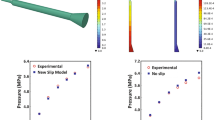Abstract
The thermal and kinetic behaviour of an elastomer flow inside an extrusion die is numerically investigated. The aim is to control scorch arisen and reduce the heating time in the mould by using viscous dissipation phenomena in order to improve the rubber compound curing efficiency. A three dimensional model, using the particle tracking technique, is developed in order to get thermal, velocity and kinetic fields through the flow. Three common geometries of an elastomer forming process are modeled: a straight runner, a bend zone and a bifurcation. This simulation is applied on the case of an EPDM (ethylene propylene diene monomer) flow. The thermal and rheological properties are experimentally characterized. The influence of viscous dissipation on the reaction progress of the melt is studied on several process conditions. Many criterions relevant for thermal and cure homogeneity are proposed in order to quantify the performance of geometry modifications.








Similar content being viewed by others
References
Brinkman H (1951) Heat effects in capillary flow I. Appl Sci Res 2:120–124
Karkri M, Jarny Y, Mousseau P (2008) Thermal state of an incompressible pseudo-plastic fluid and nusselt number at the interface fluid-die wall. Int J Therm Sci 47:1284–1293
Pujos C, Régnier N, Defaye G (2008) Determination of the inlet temperature profile of an extrusion die in unsteady flow. Chem Eng Process 47:456–462
Yataghene M, Fayolle F, Legrand J (2009) Experimental and numerical analysis of heat transfer including viscous dissipation in a scraped surface heat exchanger. Chem Eng Process 48:1445–1458
Laun H (2003) Pressure dependent viscosity and dissipative heating in capillary rheometry of polymer melts. Rheol Acta 42:295–308
Kang SY, Jayaraman K (2002) Wall slip and viscous heating effects on the flow of polypropylene/EP rubber blend in capillary rheometer. J Ind Eng Chem 8:370–374
Ha YS, Cho JR, Kim TH, Kim JH (2008) Finite element analysis of rubber extrusion forming process for automobile weather strip. J Mater Process Technol 201:168–173
Mani S, Cassagnau P, Bousmina M et al (2009) Cross-linking control of PDMS rubber at high temperatures using TEMPO nitroxide. Macromolecules 42:8460–8467
Launay J, Allanic N, Mousseau P, Deterre R (2011) Thermal and kinetic modelling of elastomer flow–application to an extrusion die. In: The 14th international ESAFORM conference on material forming (BELFAST), AIP Conf. Proc. 1353:1101–1106; doi:10.1063/1.3589663
Beaumont JP (2007) Runner and gating design handbook, 2nd edn. Hanser, Munich
Aloku GO, Yuan X-F (2010) Numerical simulation of polymer foaming process in extrusion flow. Chem Eng Sci 65:3749–3761
Agassant JF, Avenas P, Sergent JP, Carreau PJ (1991) Polymer processing: principles and modeling. Hanser, Munich
Limper A, Schramm D (2002) Process description for the extrusion of rubber compounds–development and evaluation of a screw design software. Macromol Mater Eng 287:824–835
Bird RB, Stewart WE, Lightfoot EN (2002) Transport phenomena, 2nd edn. J. Wiley & Sons, Inc
Crawford B, Watterson JK, Spedding PL, Raghunathan S, Herron W, Proctor M (2005) Wall slippage with siloxane gum and silicon rubbers. J Non-Newtonian Fluid 129:38–45
Rafei M, Ghoreishy MHR, Naderi G (2009) Development of an advanced computer simulation technique for the modeling of rubber curing process. Comp Mater Sci 47:539–547
Claxton NE, Liska JW (1964) Calculation of state of cure in rubber under variable time temperature conditions. Rubber Age 9:237–244
Isayev A, Deng J (1987) Nonisothermal vulcanization of rubber compounds. Rubber Chem Technol 69:277–312
Cheheb Z, Mousseau P, Sarda A, Deterre R (2011) Thermal conductivity of rubber compounds versus the state of cure. Macromol Mater Eng 297:228–236
Gill P, Sauerbrunn S, Reading M (1993) Modulated differential scanning calorimetry. J Therm Anal Calorim 40:931–939
Arrilaga A, Zaldua AM, Atxurra RM, Farid AS (2007) Techniques used for determining cure kinetics of rubber compounds». Eur Polymer J 43:4783–4799
Lamnawar K, Mazazouz A (2006) Rheological study of multilayer functionalized polymers: characterization of interdiffusion and reaction at polymer/polymer interface. Rheol Acta 45:411–424
Ramorino G, Girardi M, Agnelli S, Franceschini A, Baldi F, Vigano F, Ricco T (2010) Injection molding of engineering rubber components: a comparison between experimental results and numerical simulation. Int J Mater Form 3:551–554
Bagley EB (1957) End corrections in the capillary flow of polyethylene. J Appl Phys 28:624–627
Rabinowitsch B (1929) Über die viskosität und elastizität von Solen. Z Phys Chem 145:1–26, in German
Winter HH (1977) Viscous dissipation in shear flows of molten polymers. Adv Heat Tran 13:206–267
Sombatsompop N, Tan MC, Wood AK (1997) Flow analysis of natural rubber in a capillary rheometer. 1: rheological behavior and flow visualization in the barrel. Polym Eng Sci 37:270–280
Ghoreishy MHR, Razavi-Nouri M, Naderi G (2005) Finite element analysis of a thermoplastic elastomer melt flow in the metering region of a single screw extruder. Comp Mater Sci 34:389–396
Baaijens FPT (1998) Mixed finite element methods for viscoelastic flow analysis: a review. J Non-Newtonian Fluid 79:361–385
Connelly RK, Kokini JL (2007) Examination of the mixing ability of single and twin screw mixers using 2D finite element method simulation with particle tracking. J Food Eng 79:956–969
Wei D, Luo H (2003) Finite element solutions of heat transfer in molten polymer flow in tubes with viscous dissipation. Int J Heat Mass Transfer 46:3097–3108
Author information
Authors and Affiliations
Corresponding author
Rights and permissions
About this article
Cite this article
Launay, J., Allanic, N., Mousseau, P. et al. Scorch arisen prediction through elastomer flow in extrusion die. Int J Mater Form 7, 197–205 (2014). https://doi.org/10.1007/s12289-012-1120-9
Received:
Accepted:
Published:
Issue Date:
DOI: https://doi.org/10.1007/s12289-012-1120-9




